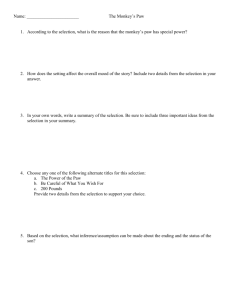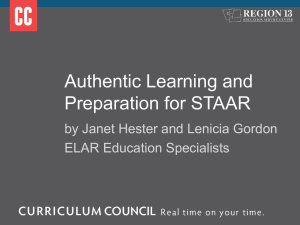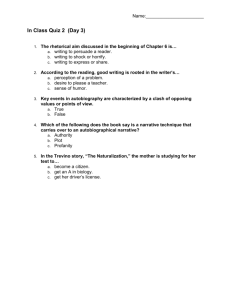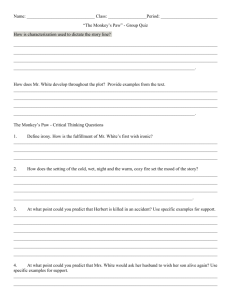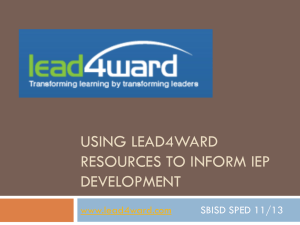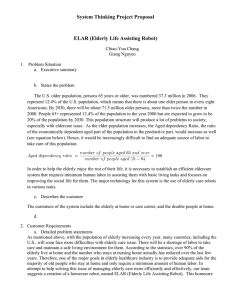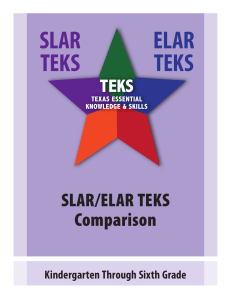truth
advertisement
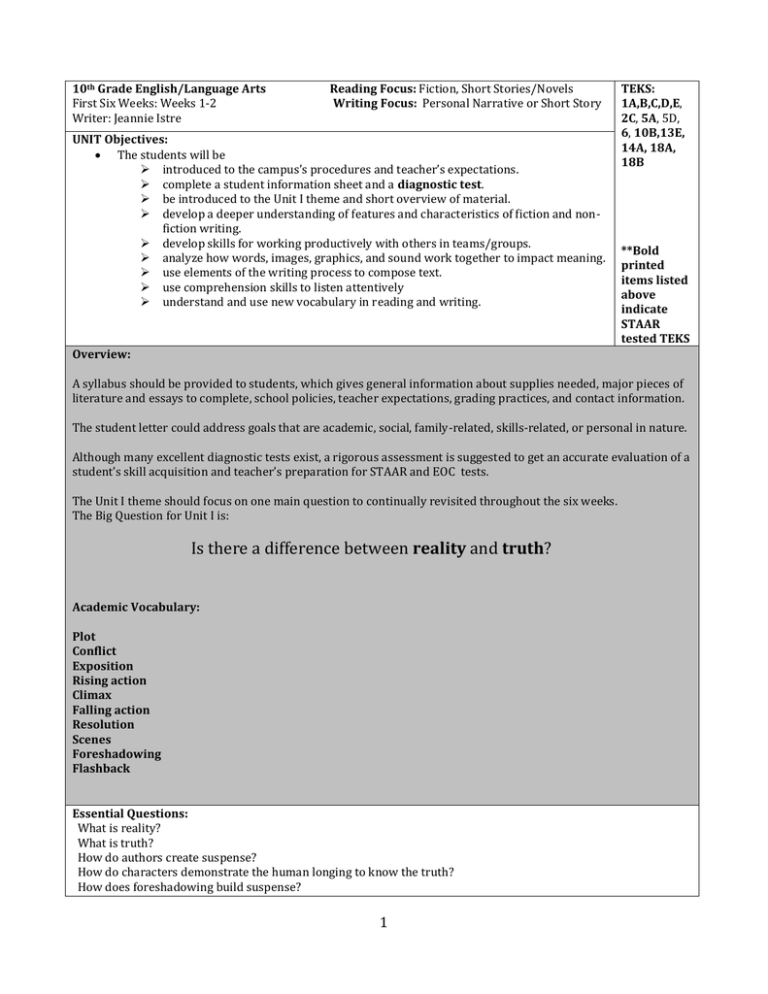
10th Grade English/Language Arts First Six Weeks: Weeks 1-2 Writer: Jeannie Istre Reading Focus: Fiction, Short Stories/Novels Writing Focus: Personal Narrative or Short Story UNIT Objectives: The students will be introduced to the campus’s procedures and teacher’s expectations. complete a student information sheet and a diagnostic test. be introduced to the Unit I theme and short overview of material. develop a deeper understanding of features and characteristics of fiction and nonfiction writing. develop skills for working productively with others in teams/groups. analyze how words, images, graphics, and sound work together to impact meaning. use elements of the writing process to compose text. use comprehension skills to listen attentively understand and use new vocabulary in reading and writing. TEKS: 1A,B,C,D,E, 2C, 5A, 5D, 6, 10B,13E, 14A, 18A, 18B **Bold printed items listed above indicate STAAR tested TEKS Overview: A syllabus should be provided to students, which gives general information about supplies needed, major pieces of literature and essays to complete, school policies, teacher expectations, grading practices, and contact information. The student letter could address goals that are academic, social, family-related, skills-related, or personal in nature. Although many excellent diagnostic tests exist, a rigorous assessment is suggested to get an accurate evaluation of a student’s skill acquisition and teacher’s preparation for STAAR and EOC tests. The Unit I theme should focus on one main question to continually revisited throughout the six weeks. The Big Question for Unit I is: Is there a difference between reality and truth? Academic Vocabulary: Plot Conflict Exposition Rising action Climax Falling action Resolution Scenes Foreshadowing Flashback Essential Questions: What is reality? What is truth? How do authors create suspense? How do characters demonstrate the human longing to know the truth? How does foreshadowing build suspense? 1 What do we learn from these texts about reading and writing? What are these stories about on a literal/deeper level? What must we do in order to understand why a story affects us as it does? How does the setting affect the development of a narrative(plot, conflict, characters, mood) Suggested Lesson Ideas: 1. Diagnostic Test: A portion of a released TAKS Test or EOC exam can serve as a common assessment or diagnostic assessment. Teachers will score the open-ended responses using the STAAR Reading Rubric for short answer single selection and STAAR Reading Rubric for connecting selections. Enrichment: Close read, note-taking, and review of answers could be done after completion of the test as a class. Intervention: One-on-one tutoring with students who earned very low scores. 2. “The Monkey’s Paw” – W.W. Jacobs for Regular ELA II “The Leap” - Louise Erdrich for AP ELA II Before reading: Students will complete a Quick Write on the journal topic using the story’s Big Question, “Is there a difference between reality and truth?” Review academic vocabulary on page 31 or 44 by using various vocabulary building strategies. Have students create a concept map, Frayer model, vocabulary cluster, or other graphic organizer to reinforce vocabulary comprehension. Introduce the details/background of the author/text. Divide class into groups of no more than 4. Assign each group one of the Activating Prior Knowledge statements found on page 32 of the TE for “The Monkey’s Paw” and page 46 for “The Leap.” Allow groups time to discuss both the pros and cons of the issue, come to a consensus, and write a one paragraph explanation of their consensus. Allow groups to share their explanation with the class if time allows. Save the group responses for After Reading. During reading: Pages 31-43 or 45-54. Read to comprehend. Post the following comprehension questions: What is happening? How do you know? Who are the characters? What do you know about them? How do you know? Explain to the students that stopping periodically to answer these questions during the reading of the text will assist in providing a better understanding of the story. Analyze point of view. Ask: From what point of view is the story told? Who is telling the story? What is the effect on you as a reader? As the students read the story, have them identify what they think are significant moments or sentences. These moments may be related to the characters, conflicts, settings, lessons learned, key plot events, etc. Model creating a two-column chart or T Chart. The significant moments should be on the left column and an explanation sentence should be on the right side. Press students to be specific and refer to the text in their explanation. This will better prepare them for STAAR. After reading: Discussion of story and literary terms. Return to groups to assess whether their views have changed from their initial responses of their assigned Activating Prior Knowledge statement. Return to be Big Question and allow students to discuss the question in reference to the selection they have read. Enrichment for “The Monkey’s Paw”: Discuss the common theme of “wishing” in literature and how three wishes usually end badly. Have students write a short essay discussing or explaining the universal appeal of the plot structure and why there are no stories about getting wishes granted without consequences. 2 Have students imagine they are choosing background music for a movie version of this story. They should be able to explain why this piece of music was chosen to address literary elements tone and mood as well as explain the definition of tone and mood in their own words. Enrichment for “The Leap”: Create an informative illustration of trapeze artists such as those mentioned by narrator in the story. This should include facts on circus popularity, safety, and/or training of trapeze artists. Differentiation/Intervention: Identify at least three significant moments in the plot for students who might struggle. Allow them to write the explanation on their chart. Culminating Project Ideas: Complete Writing – page 57. Write a sequel to “The Monkey’s Paw” as to what might happen if someone else finds the paw, add music, and illustrations. Write a sequel to “The Leap” describing the mother’s next daring rescue, add music, and illustrations. Write a autobiographical narrative about some difficult task that you have overcome and its uncertainty (It can be fictional.) Develop interview questions and role play the Whites and interview them after their final wish. Develop interview questions and role play an interview between a journalist who is writing about circus families and the journalist. Write Like: Write your own short story. Write an article about your present day music (rap, heavy metal, rock, etc.) similar to the two about jazz. Intervention: Create a storyboard for The Monkey’s Paw”, “The Leap” or . Be prepared to present your effort to the class. Develop rubrics for grading and assessing oral presentations. Suggested Assessment for “The Monkey’s Paw”: Students could complete an open-ended or multiple choice quiz from the ancillary material or complete critical reading questions from pages 42-43. Selection Tests Vocabulary Two column or T Chart Suggested Assessment for “The Leap”: Students could complete an open-ended or multiple choice quiz from the ancillary material or complete critical reading questions from pages 54-55. Selection Tests Vocabulary Two column or T Chart Resources: Prentice Hall Literature Textbook Region 4. Scope and Sequence with Assessments: English Language Arts/Reading – English II Other diagnostic material in ancillaries Ancillary quizzes 3 10th Grade English/Language Arts First Six Weeks: Week 3 Writer: Jeannie Istre Reading Focus: Non-Fiction Writing Focus: Descriptive Objective: The student will: Understand new vocabulary and use it when reading and writing. Examine the author’s purpose as you read. Explain to students that an author uses certain details to reveal his/her perspective. Develop a deeper understanding of features and characteristics descriptive writing. Develop skills for working productively with others in teams/groups. Analyze how words, images, graphics, and sound work together to impact meaning. Use elements of the writing process to compose text. Use comprehension skills to listen attentively TEKS: 1A, 6, 10A, 13C, 23C **Bold printed items listed above indicate STAAR tested TEKS Essential Questions: What do we learn from these texts about reading and writing? What are these stories about on a literal/deeper level? What must we do in order to understand why a story affects us as it does? How does the setting affect the development of a narrative (plot, conflict, characters, mood) What details reveal the realities Cox faces during her swim? What are some ways the author challenges reality to fight for the job of streetcar conductor? Suggested Lesson Ideas: “Swimming to Antartica” by Lynne Cox pp. 61-74 (Regular ELA) “Occupation: Conductorette” by Maya Angelou pp. 79-84 (AP ELA) Before reading: Students will complete a Quick Write in their journal to extend on the following thought: “Facing uncertainty about your ability to accomplish a difficult task is an opportunity to ___________________. Review academic vocabulary page 60 or 76. Develop a crossword puzzle with vocabulary from both stories (from weeks 1-3) and have students complete the puzzle. Have the students create a fiction or non-fiction 1 page essay that includes a minimum of 8 vocabulary words used in the appropriate context. This may be done as a homework assignment. Introduce the details/background of the author/text. During reading: 1. From Swimming to Antartica – Lynne Cox or Occupation: Conductorette – Maya Angelou Use the GIST Strategy with the second story also to familiarize students with its benefits. If students are already familiar with the strategy. Use the groups or popcorn reading strategy. Read to comprehend. Post the following comprehension questions: What is happening? How do you know? Who are the characters? What do you know about them? How do you know? Explain to the students that stopping periodically to answer these questions during the reading of the text will assist in providing a better understanding of the story. Analyze point of view. Ask: From what point of view is the story told? Who is telling the story? What 4 is the effect on you as a reader? Use Reading Graphic Organizer B of Unit 1 Resource Book to assist students with making predictions. Differentiation/Intervention: Struggling readers may read listen attentively and take notes, read along with the online assistance or with the CD recorded selection. Ask students to take notes on a section of a graphic organizer shaped like a tree, and share the notes from their section of the text with other groups. After reading: Discussion of story and literary terms. Return to the Big Question and discuss its significance to this story. Have the students complete Critical Thinking, p. 74 or 84. Administer Selections Tests desired. Suggested Assessment: Selection Tests Crossword Puzzle Vocabulary Vocabulary Essay Graphic Organizer Reader’s Notebook Resources: Prentice Hall Literature Textbook Prentice Hall Grammar Textbook Ancillary quizzes Teacher developed material 5 11th Grade English/Language Arts First Six Weeks: Week 4 Writer: Jeannie Istre Grammar Focus: Abstract/Concrete Nouns Writing Focus: Autobiographical Narrative Objective: Understand new vocabulary and use it when writing. Edit drafts for grammar, mechanics, and spelling. ELAR 10.13D (RS) CCSS L10.1, 2 Use correct punctuation marks. ELAR 10.18B (RS) CCSS L10.2 Use a variety of correctly structured sentences. ELAR 10.17C (RS) CCSS L10.1 Analyze the controlling idea and specific purpose of a passage and the textual elements that support and elaborate it, including both the most important details and the less import details. ELAR 10.8A (RS) CCSS RL10.2 TEKS: 1, 8, 13A, B, C, D; 14A, 16A, 17C, 18B(ii) **Bold printed items listed above indicate STAAR tested TEKS Essential Questions: What do we learn from these texts about writing? What are these stories about on a literal/deeper level? What must we do in order to understand why a story affects us as it does? How does the setting affect the development of a narrative (plot, conflict, characters, and mood) in our own writing? Suggested Lesson Ideas: Develop and teach a mini-lesson in review of conventions for nouns: common, proper, abstract, possessive and concrete. Develop and administer exercises as needed for mastery of grammatical skill. Allow students to complete both Integrated Language Skills on pages 56 and 86. Teach Informational Texts pages 90-95. Use the Texas Writing Workshop on pp. 108-113 to assist in writing an Autobiographical Narrative. Suggested Assessment: Grammar Exercises - Nouns Autobiographical Narrative with Rubric pg. 113 Informational Texts Chart pg. 90 Resources: www.PHLitOnline.com Prentice Hall Literature Textbook Ancillary quizzes Teacher created material Unit Resources 6 10th Grade English/Language Arts First Six Weeks: Week 5 Writer: Jeannie Istre Reading Focus: Fiction TEKS: Literary Focus: Cause & Effect 1, 2A, B, C, Internal/External Conflict 5A, B, C, 6, 7, 8, 17A, Fig. 19B Objective: The students will Understand new vocabulary and use it when reading and writing. Use and understand the function of the parts of speech in the context of reading, writing, and speaking. Analyze the controlling idea and specific purpose of a passage and the textual elements that support and elaborate it, including both the most important details and the less import details. ELAR 10.8A (RS) CCSS RL10.2 Analyze, make inferences and draw conclusions about theme and genre in different cultural, historical, and contemporary contexts and provide evidence from the text to support their understanding. ELAR 10.2 ELPS4J, 4K Understand, make inferences and draw conclusions about the structure and elements of fiction and provide evidence from text to support their understanding. ELAR 10.5(RS) Understand, make inferences and draw conclusions about the varied structural patterns and features of literary nonfiction and provide evidence from text to support their understanding. ELAR 10.6A (S) (CCRS lll A1, A2) CCSS SL10.1b Understand, make inferences and draw conclusions about how an author’s sensory language creates imagery in literary text and provide evidence from text to support their understanding. ELAR 10.7A (S) Understand the function of and use the conventions of academic language when speaking and writing. ELAR 10.17 Make complex inferences about text and use textual evidence to support understanding. ELAR Fig. 19B (RS) Essential Questions: How would you characterize the style of the passage? What is the tone of the passage? How does the author’s use of figurative language enhance the plot in this fictional selection? What can the reader tell about ___(a specific character) based on a metaphor the author uses to describe him/her? Why is paragraph ___ so important in helping the reader to understand _____(a specific character)? How does the author increase the complexity of ____(a specific character)? To create a believable character in “Lamb to the Slaughter”, the author uses ______________. Suggested Lesson Ideas: “Lamb to the Slaughter” Before Reading: Introduce the Reading Skill: Cause and Effect and Literary Analysis Concept: Author’s Purpose. With graphic organizers. Mini-lesson to teach the vocabulary and Word Power Skill. Use Unit 1 Resources to check Vocabulary/Fluency/Prior Knowledge. During Reading: As students read aloud, check comprehension using the Reading Check questions and Essential Questions. After Reading: Assign Critical Thinking activity of teacher’s choice. Invite students to write about a recent incident in which they tempted to act irrationally and the outcome of their action. How did they handle the situation? What was the effect of their actions? (QuickWrite) Tell students that they should write like the authors of the texts in crafting their incident. Ask learners to share what they have written in a turn and talk; then ask volunteers to share with the whole 7 group. Administer Six Weeks Common Assessment. Suggested Assessment: Critical Thinking Teacher Created Selection Test Graphic Organizers Unit 1 Resources 1st 6 Weeks CBA Resources: Prentice Hall Literature Textbook Prentice Hall Grammar Textbook Standardized rubric Teacher created material 8 English II Checklist First Six Weeks At the completion of the First Six weeks, the student will be able to: _________ Complete diagnostic test(s) _________ Understand and explain the yearlong theme _________ Set goals in the form of an information sheet _________ Learn different note-taking strategies _________ Identify the parts of speech (concrete/abstract nouns) in sentence _________ Analyze the parts of an argument and rhetorical techniques in a speech or written document _________ Complete the writing process to create an autobiographical essay _________ Identify the parts of plot in a short story _________ Identify differences of concrete/abstract nouns as well as possessive nouns _________ Identify cause and effect in a fictional work _________ Identify internal and external conflict _________ Pass a Reading Selection Assessment _________ Pass the Six Weeks Test 9
